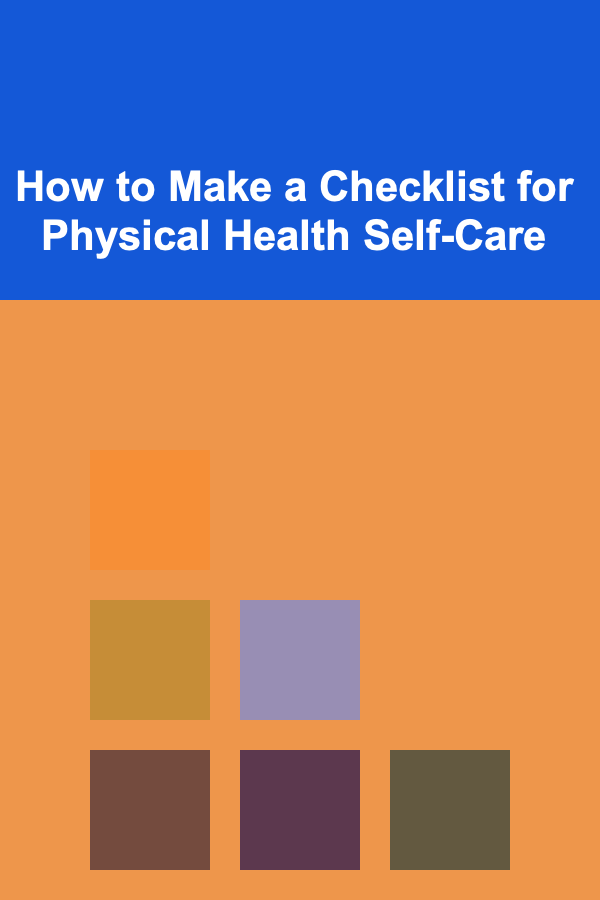
How to Make a Checklist for Physical Health Self-Care
ebook include PDF & Audio bundle (Micro Guide)
$12.99$9.99
Limited Time Offer! Order within the next:

Physical health self-care is an essential aspect of maintaining overall well-being and quality of life. It involves daily actions and decisions that contribute to our health, fitness, and longevity. Having a checklist for physical health self-care can help you stay organized, focused, and consistent in taking care of your body. In this actionable guide, we will walk through how to create a personalized checklist for physical health self-care that aligns with your goals and needs.
Why a Physical Health Self-Care Checklist is Important
A physical health self-care checklist serves as a roadmap for ensuring you are addressing all aspects of your physical well-being. It can help you:
- Stay Consistent: Regularly tracking your actions ensures you are consistent in maintaining a healthy lifestyle.
- Prioritize Health: A checklist helps you focus on what matters most for your health and fitness goals.
- Track Progress: It allows you to track improvements and areas that need attention, making adjustments easier.
- Create Routine: A checklist can create a healthy, sustainable routine that becomes second nature over time.
Whether you are trying to lose weight, improve fitness, manage stress, or simply maintain your physical health, a well-organized checklist can make these tasks more manageable and achievable.
Step-by-Step Guide to Creating Your Physical Health Self-Care Checklist
Creating a checklist for your physical health self-care requires assessing your current needs, setting realistic goals, and ensuring that you address key health areas consistently. Here's how you can develop a comprehensive, actionable checklist.
1. Assess Your Current Physical Health Status
Before you start creating your checklist, it's important to take stock of your current physical health. This includes evaluating:
- Your Fitness Level: Are you currently exercising regularly? What activities do you enjoy, and what are your fitness goals?
- Nutrition: Are you eating a balanced diet that supports your health needs? Do you consume enough fruits, vegetables, proteins, and hydration?
- Sleep: Are you getting enough quality sleep each night to allow your body to recover and function optimally?
- Stress Levels: How are you managing stress? High stress can negatively affect physical health, so it's important to include stress management techniques.
- General Well-Being: Consider how you feel overall. Do you have any chronic conditions or concerns that should be addressed through self-care?
2. Identify Key Areas of Focus
Once you have assessed your current physical health, you need to identify the key areas that you want to focus on. These might vary depending on your individual health goals, but they generally include the following categories:
Exercise and Physical Activity
Physical activity is crucial for maintaining a healthy body. Regular exercise improves cardiovascular health, strengthens muscles and bones, boosts mood, and increases energy levels.
- Cardio: Include activities such as running, walking, cycling, or swimming to improve heart health.
- Strength Training: Incorporate weightlifting or bodyweight exercises to build muscle and increase metabolism.
- Flexibility: Add stretching, yoga, or Pilates to improve flexibility and prevent injuries.
- Rest Days: Ensure you schedule recovery days to prevent burnout and muscle overuse.
Nutrition and Hydration
Proper nutrition and hydration play a key role in supporting physical health. Your body needs a variety of nutrients to perform essential functions, maintain energy levels, and repair itself.
- Balanced Diet: Include a mix of whole foods, such as fruits, vegetables, lean proteins, healthy fats, and whole grains.
- Meal Timing: Consider how frequently you eat throughout the day and how it affects your energy levels and metabolism.
- Hydration: Ensure you are drinking enough water each day to stay hydrated and support bodily functions. A general guideline is 8 cups (2 liters) of water per day, but this varies depending on activity levels and climate.
Sleep and Rest
Adequate sleep is crucial for your body's recovery, mental clarity, and overall well-being. Poor sleep can lead to fatigue, decreased immune function, and poor concentration.
- Sleep Duration: Aim for 7-9 hours of sleep each night to allow your body to rest and regenerate.
- Sleep Environment: Create a calming sleep environment by minimizing light, noise, and distractions.
- Bedtime Routine: Establish a consistent bedtime routine to signal to your body that it's time to unwind, such as reading, meditating, or practicing deep breathing.
Stress Management
Chronic stress negatively impacts physical health and can lead to conditions like high blood pressure, heart disease, and weight gain. Implementing stress management techniques is crucial for maintaining balance.
- Mindfulness Practices: Incorporate techniques like meditation, deep breathing, or journaling to manage stress effectively.
- Time for Hobbies: Ensure you're engaging in activities you enjoy to reduce stress and promote relaxation.
- Relaxation Techniques: Practice progressive muscle relaxation, yoga, or listening to calming music to unwind.
Preventive Health
Taking preventive measures can help you avoid illness and maintain good health. This includes monitoring and addressing any existing conditions and proactively seeking medical care when necessary.
- Regular Checkups: Schedule annual physical exams and any recommended screenings for your age group or risk factors.
- Vaccinations: Stay up to date with necessary vaccinations to protect yourself from preventable diseases.
- Self-Exams: Conduct self-checks, such as breast or testicular self-exams, and monitor for any unusual symptoms.
3. Set Realistic and Achievable Goals
Your physical health checklist should include specific, measurable, attainable, relevant, and time-bound (SMART) goals. For example:
- Exercise: "Walk for 30 minutes, 5 days a week, for the next 4 weeks."
- Nutrition: "Increase vegetable intake to 5 servings per day by the end of the month."
- Sleep: "Improve sleep quality by establishing a bedtime routine and sleeping 8 hours per night for the next two weeks."
- Stress Management: "Practice meditation for 10 minutes every morning for the next week."
Setting realistic goals helps prevent burnout and ensures that you are making gradual progress in improving your health.
4. Create the Checklist
Now that you have identified your focus areas and goals, it's time to create the actual checklist. Your checklist should be simple, organized, and easy to follow. It can be digital or physical, depending on what suits your lifestyle.
Example of a Physical Health Self-Care Checklist
-
Exercise
- [ ] Walk for 30 minutes, 5 days a week
- [ ] Strength train 2 times a week
- [ ] Practice stretching or yoga for 15 minutes daily
-
Nutrition
- [ ] Eat 3 servings of vegetables per day
- [ ] Drink 2 liters of water per day
- [ ] Eat a balanced breakfast every day
-
Sleep
- [ ] Get 8 hours of sleep per night
- [ ] Follow a relaxing bedtime routine
- [ ] Avoid screens 30 minutes before bed
-
Stress Management
- [ ] Meditate for 10 minutes each morning
- [ ] Practice deep breathing exercises during stressful moments
- [ ] Dedicate 1 hour per week to a hobby or activity you enjoy
-
Preventive Health
- [ ] Schedule an annual physical exam
- [ ] Get recommended vaccinations
- [ ] Perform self-checks for early signs of health issues
5. Review and Adjust Regularly
Your physical health self-care checklist should not be static. Regularly reviewing and adjusting it helps you stay on track and make improvements as needed. Consider:
- Weekly Check-ins: Review your checklist at the end of each week to evaluate your progress and make any necessary adjustments.
- Monthly Review: Assess your goals monthly to see if they're still aligned with your evolving health needs or if new priorities should be added.
Conclusion
Creating a physical health self-care checklist is a powerful tool for taking charge of your health and well-being. By assessing your current health status, setting achievable goals, and maintaining a consistent routine, you can create a checklist that will help guide you toward better physical health. Remember that self-care is an ongoing journey, and a checklist can serve as a valuable reminder to prioritize your health every day. Start simple, stay consistent, and celebrate your progress along the way!
Reading More From Our Other Websites
- [Home Holiday Decoration 101] How to Light Up Your Home for the Holidays with String Lights
- [Organization Tip 101] How to Organize Digital Memories for a Virtual Time Capsule
- [Hiking with Kids Tip 101] Conquering the Cliff: Fun Ways to Ease Your Child's Fear of Heights on Hiking Trails
- [Home Security 101] How to Use Smart Floodlights for Enhanced Outdoor Security
- [Home Storage Solution 101] How to Organize Your Garage with Custom Storage Systems
- [Personal Care Tips 101] How to Mix Perfume with Other Fragrances for a Unique Scent
- [Tie-Dyeing Tip 101] Vibrant DIY: Mastering Tie-Dye with Everyday Food Coloring
- [Home Party Planning 101] How to Leverage Party Planning Companies for Innovative Ideas
- [Organization Tip 101] How to Reevaluate Your Workspace Organization Regularly
- [Home Staging 101] How to Differentiate Home Staging from Interior Design

How to Choose the Right Music Playlist for Any Occasion
Read More
How to Organize a Themed Costume Party at Home
Read More
How to Plan a Family Volunteer Day for a Good Cause
Read More
How to Set Up an Emergency Fund Before Investing
Read More
How to Use Color Coding for Shared Items
Read More
How to Navigate the Vibrant Markets of Mexico City
Read MoreOther Products

How to Choose the Right Music Playlist for Any Occasion
Read More
How to Organize a Themed Costume Party at Home
Read More
How to Plan a Family Volunteer Day for a Good Cause
Read More
How to Set Up an Emergency Fund Before Investing
Read More
How to Use Color Coding for Shared Items
Read More